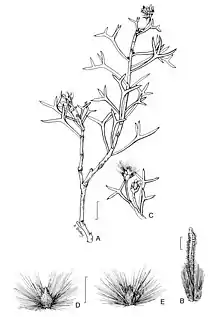Petrophile pauciflora
Petrophile pauciflora is a species of flowering plant in the family Proteaceae and is endemic to western areas of Western Australia. It is a shrub usually with three-forked leaves, the lobes sharply-pointed, and spherical heads of small groups of hairy yellow or orange flowers.
| Petrophile pauciflora | |
|---|---|
 | |
| A=flowering branchlet; B=flower; C=fruiting branchlet; D,E=upper and lower surfaces of nut | |
| Scientific classification | |
| Kingdom: | Plantae |
| Clade: | Tracheophytes |
| Clade: | Angiosperms |
| Clade: | Eudicots |
| Order: | Proteales |
| Family: | Proteaceae |
| Genus: | Petrophile |
| Species: | P. pauciflora |
| Binomial name | |
| Petrophile pauciflora Foreman[1] | |
Description
Petrophile pauciflora is a shrub that typically grows to a height of 0.5–1 m (1 ft 8 in–3 ft 3 in) and has hairy young branchlets and leaves that become glabrous as they age. The leaves are 15–35 mm (0.59–1.38 in) long and cylindrical but three-forked, the middle segment sometimes divided again, each segment sharply-pointed. The flowers are arranged near the ends of branchlets in spherical heads about 8 mm (0.31 in) in diameter, with egg-shaped involucral bracts at the base. The heads contain only a few flowers, each about 7 mm (0.28 in) long, yellow or orange, and hairy. Flowering has been observed in September and the fruit is a nut, fused with others in an oval or spherical head 6–8 mm (0.24–0.31 in) long.[2][3]
Taxonomy
Petrophile pauciflora was first formally described in 1995 by Donald Bruce Foreman in Flora of Australia from material collected by Alex George near Bimbijy Station in 1976.[4] The specific epithet (pauciflora) means "few-flowered".[5]
Distribution and habitat
This petrophile grows in low, open heathland on breakaway areas in a few locations in the Avon Wheatbelt, Murchison and Yalgoo biogeographic regions of Western Australia.[2][3]
Conservation status
Petrophile pauciflora is classified as "Priority Three" by the Government of Western Australia Department of Parks and Wildlife[3] meaning that it is poorly known and known from only a few locations but is not under imminent threat.[6]
References
- "Petrophile pauciflora". Australian Plant Census. Retrieved 23 December 2020.
- Foreman, David B. "Petrophile pauciflora". Australian Biological Resources Study, Department of Agriculture, Water and the Environment: Canberra. Retrieved 23 December 2020.
- "Petrophile pauciflora". FloraBase. Western Australian Government Department of Parks and Wildlife.
- "Petrophile pauciflora". APNI. Retrieved 23 December 2020.
- Sharr, Francis Aubi; George, Alex (2019). Western Australian Plant Names and Their Meanings (3rd ed.). Kardinya, WA: Four Gables Press. p. 272. ISBN 9780958034180.
- "Conservation codes for Western Australian Flora and Fauna" (PDF). Government of Western Australia Department of Parks and Wildlife. Retrieved 23 December 2020.
